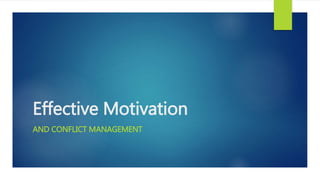
Effective motivation
- 1. Effective Motivation AND CONFLICT MANAGEMENT
- 2. Motivating, Preventing, and Leading; Strategies and Methods • Elizabeth is motivated by the knowledge of her abilities to perform and accomplish tasks in a timely, efficient, and effective manner, who is always willing to work as a team player; also demonstrates growth and flexibility. • Natalie who is known for providing accurate and detailed work. She is motivated by individual recognition and praise of her accomplishments. • William who has troubles getting motivated at times is often encourage by being assigned challenging tasks. He is also appreciative and motivated by recognition and positive feedback. • Ian is motivated by self-achievement.
- 3. Motivating a Team of Diverse Individuals using the “Collective System Method”, according to Chiocchio, Kelloway, & Hobbs (2006) Create a common objective: Creating a common goal will encourage team members to work together to accomplish a common objective. Create individual goals for team members: Create specific goals for each team member, this enables individuals to assume credit for accomplishing their individual task. Individual Goals should consist of: Focusing on an effective and efficient plan individual goals must contain specific elements; project identification, project definition, project service acceptance, and project change impacts.
- 4. Upon goal accomplishment deliver positive group feedback In addition, team members will be increasingly motivated through individual praise and recognition. The expected outcome of the project is additionally a motivator for team members, those looking to progress within the company will have a chance to stand out by demonstrating their competency and capabilities of putting together an extremely important project within a limited time frame and the priority of multitasking to ensure daily tasks are completed effectively and efficiently in addition to the new assignment.
- 5. Managing Intrapersonal Conflict through Prevention and Intervention Green (2006) states that a great way to prevent conflict amongst teams begins by selecting individuals for the group who are able to complete goals and critical tasks in a time sensitive manner in order to decrease unnecessary challenges or conflicts. In addition, Kreitner & Kinicki (2013) describe various ways to manage conflict: • Ensuring no negative interactions between team members • Encourage team building • Inspire close work relationships between team members • Emboss positive attitudes within the group • Discourage negative gossip and behavior Although, all four team members have diverse personalities in relationship to how they handle conflict and what works best as a means of intervention and diffusion; the preceding methods essentially will work with all team members.
- 6. Leadership Strategies In order to be effective leaders, it is extraordinarily important that managers possess key fundamentals such as the ability for each manager to acknowledge and understand their strengths and weaknesses as leaders. The Deming Legacy suggest that specific managerial traits play a great role in profitability. Deming expressed that improvement should come from changes in how managers are trained, for example, manager training should incorporate: helpful leadership, decreasing employee fear, and optimizing team work. Clark Wilson’s theory focuses on effective and efficient communication with people. This claim insist through such measures, customers and employees are able to describe the values and standards placed upon them via upper management (Kreitner &. Kinicki, 2013).
